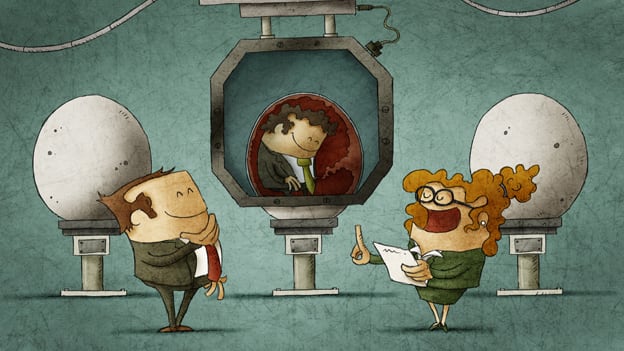Building cocoons of ideation for problem solving and transformation

With increase in global financial pressures, shifting demographics, an emerging consumer base and favorable business policies defining new markets becoming the drivers to sustainable business strategies, the youth of today will have to be prepared for the continuous transition and transformation in order to withstand business pressures in this VUCA world beyond borders. Organizations of the future with technology-integrated global operations will have a multi-cultural and multi-generational workforce interconnected beyond time and geographic boundaries with high expectations of outcomes. More and more organizations with flatter horizontal structures will create a greater focus on gender diversity and inclusion for social equity.
Real life is complex and multi-faceted. There are multiple interlinked issues and players that create an impact, and hence one cannot adapt a simple linear approach to problem-solving. Also problems cannot be solved in a disconnected manner. One has to get hands-on and amidst the scenario to arrive at feasible and workable solutions by doing more with less. Design is not just about problem-solving, it is an explorative and collaborative evolution of both the problem and solution spaces, questioning, refining, and changing the focus, direction and scope of the problem as part of the process of creating solutions. Thus, there is a strategic need to take an interdisciplinary design thinking approach to problem solving.
Discipline-specific study may be useful for someone desirous of gaining specialization in particular subject. However, at times it may be fragmented, create a myopic view of the discipline and may prove inadequate for meeting educational goals. Cross-disciplinary connections and integrative approaches on the other hand encourage creative thinking, develop cognitive skills, enhance sensitivity and fire the passion to make a change by engaging the students. They are able to embrace ambiguity, become more tolerant , able to overcome any preconceptions or bias, establish a humane connect , be more empathetic and caring in their problem solving process. The learning gained is in the form of acquisition of basic foundational as well as critical knowledge through synthesis and integration of ideas with application of insights across multiple disciplines and assimilation of the knowledge gained. It helps develop new skills, accelerates progress and builds capacity for leadership.
Design empowers the individual with the appropriate tools and techniques to facilitate conduct of research and collect inputs from sections of society or organizations. Based on these, insights are drawn, keeping multidimensional and multiple stakeholder perspectives in mind. Design enables to process rigorous and rapid prototyping of the most feasible solution to solve the problems, with management providing with the sustainable models of commercialization and value creation, capturing evidence and success stories. In order to develop sharp managerial skills in students, it is necessary to expose them to critical, demanding and complex real life situations and challenges and keep them stimulated.
As this journey of self-transformation begins with awareness about self, realization of one’s core values and principles, identification of role and responsibility of self in organization and impact on society, the students are able to motivate self and others, respect other’s view points and perspectives, develop willingness to share and support others, learn to collaborate for co-creation to achieve a common shared goal. In the process they are able to face adversity by leveraging the strength of diversity and empowering team culture. Skills developed include verbal and non-verbal communication skills, leadership , innovation ability, global perspective, creative, critical and analytical problem-solving, ability to contribute to society, interpersonal relationships, self-confidence, commitment, self-efficacy, values, and work ethics.
As management is a mix of science and art, the science can never be understood and learnt unless students pursue and practice the art of experimentation. The ability to recognize failure and learn from one’s own mistakes makes an individual more confident and focused when exposed to challenging situations. It provides the tensile ability to stretch in times of stress and recoil back reaching normalcy in a much more controlled manner. Practical experience also improves decisiveness, as practice maketh a man perfect. Exposure to critical situations earlier on in the student days sharpens their ability to take risks, think fast and apply logical reasoning; having had the experience of managing a similar situation earlier.
Reflection is the key to learning from experience as it consciously focuses one’s attention on what one has learnt and helps consolidate it. Reflection is an essential element to self-development. It allows one to introspect and think on one’s behaviors in certain situations. It helps to analyse actions and reactions and makes one to think about how one could have responded differently if given a second chance. It helps in self-judgement about the logic and rationale for one’s actions and impact.
Collaboration, creativity and innovation thus become key objectives and differentiators of performance, with ideation and creativity becoming essential parts of both business as well as personal development. A confluence of these factors helps develop a certain degree of maturity to manage peers and subordinates, giving the courage to hold oneself responsible and accountable; which are some of the very important traits of a good leader.
Whilst the intentions of an academic institution to foster leadership and talent development are very clear and focused, they cannot be fulfilled without the active participation from the industry so developing excellent Industry-Academia linkages assumes paramount importance. In keeping with the changing times, the means and ways in which Industry-academia collaborate to develop curricula, guest lectures by industry stalwarts, case study, mentoring, live projects, arranging industry visits / tour and internships have also begun to undergo metamorphosis . Live challenges give a sense of responsibility to the student and generate accountability for the outcomes and deliverables. In the process of the project work, students get an opportunity to interact across departments and hierarchies within the organization. An interface of trust is created that helps nurture an understanding about the organizational values, work culture and business ethics. It also provides the students with a first-hand exposure to the criticality of the problem statement to business functioning and outcomes. A strong industry-institute interface is indicative of the level of trust between both partners and provides for a platform for taking on diverse challenges across industry sectors and creating solutions for the benefit of all stakeholders. - Contributed by Prof Dr Uday Salunkhe, Group Director and Prof Dr Ragini Mohanty , Head - Healthcare Management Programs, WeSchool
With a reputation based on sector specific programs with excellent industry linkages and combined with the deep embedding of design thinking, innovation and leadership, with an outcome driven approach in its strategy for Industry-Institute Interaction, WeSchool is adjudged the ‘AICTE-CII Best Industry linked Management Institute ‘in the country recently.












